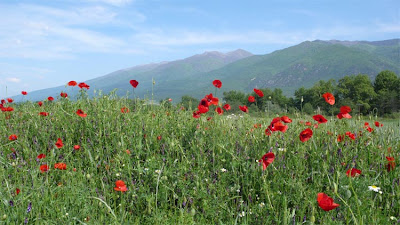Northern Greece
10 – 17 May 2014
A week-long guided bird and wildlife holiday with Steve Dudley
Min. group size 3, max. group size 6
Price c.£1300-1400 per person (to be confirmed, excludes flights).
Northern Greece is a large area with a fabulous variety of landscapes from mountains to lowland wetlands. And it is packed with birds!
 Black Vultures look you right in the eye in Northern Greece!
Black Vultures look you right in the eye in Northern Greece!We will meet up at Theassaloniki airport at 1430h.
Based on 2013 flights, I recommend the following flights to Thessaloniki:
From Lesvos (for those combining Lesvos with this trip) - Aegean Airlines - dep. Mytilini c.10.30, arr. Thessaloniki c.11.30h.
From Gatwick - BA – dep. Gatwick c. 08.30, arr. Thessaloniki c.13.45h.
Those wishing to use other routes/carriers must be at the meeting point at Thessaloniki airport at 1500h.
Other routes/carriers: Gatwick (EasyJet), Heathrow (Aegean) and Stansted (Ryanair).
We will transfer from Thessaloniki to our hotel overlooking Lake Kerkini. After freshening up we will spend the late evening watching part of Lake Kerkini.
Day 2 – 4 – Lake Kerkini and surrounding areas
The first half of our week will be spent birding in and around the utterly fabulous Lake Kerkini. Our hotel sits on a hillside overlooking the lake providing breathtaking bedroom views.
Lake Kerkini is a vast reservoir made by the building of a dam in 1932 and flooding an area over 100km2. At its two widest points it is 17km long and 5km wide – it’s big!
The lake is home to vast numbers of wetland species including breeding Dalmatian and White Pelicans, Pygmy and Great Cormorants, Night-herons, egrets, herons, wildfowl and waders. Wherever you stand around the lake you’ll have masses to see. But no area is as good as the north-west corner – the home of the drowned forest where most of the tree-nesting species breed. The north-west corner is also the point at which the River Strimonas flows in to the lake and this provides a natural river highway for arriving and departing flocks of Great Cormorants and pelicans.
The woodland and field areas bordering the lake is not to be ignored either. Grey-headed, Lesser Spotted, Syrian, Middle Spotted and Great Spotted Woodpeckers all breed here, along with many warblers (including Moustached and Great Reed), shrikes and Hawfinch.
Further afield, time, weather and snow line permitting, we’ll search the foothills of the adjacent Kerkini mountains for the extremely elusive White-backed and Black Woodpeckers. The wooded mountain slopes also contain many other species including Common Treecreeper, Marsh Tit and Semi-collared and Collared Flycatchers. Eagle Owl is also a possibility. We'll also spend some time searching in the wider Kerkini area for Roller, Western Rock Nuthatch, woodpeckers and other species.
Lake Kerkini is a vast reservoir made by the building of a dam in 1932 and flooding an area over 100km2. At its two widest points it is 17km long and 5km wide – it’s big!
The lake is home to vast numbers of wetland species including breeding Dalmatian and White Pelicans, Pygmy and Great Cormorants, Night-herons, egrets, herons, wildfowl and waders. Wherever you stand around the lake you’ll have masses to see. But no area is as good as the north-west corner – the home of the drowned forest where most of the tree-nesting species breed. The north-west corner is also the point at which the River Strimonas flows in to the lake and this provides a natural river highway for arriving and departing flocks of Great Cormorants and pelicans.
The woodland and field areas bordering the lake is not to be ignored either. Grey-headed, Lesser Spotted, Syrian, Middle Spotted and Great Spotted Woodpeckers all breed here, along with many warblers (including Moustached and Great Reed), shrikes and Hawfinch.
Further afield, time, weather and snow line permitting, we’ll search the foothills of the adjacent Kerkini mountains for the extremely elusive White-backed and Black Woodpeckers. The wooded mountain slopes also contain many other species including Common Treecreeper, Marsh Tit and Semi-collared and Collared Flycatchers. Eagle Owl is also a possibility. We'll also spend some time searching in the wider Kerkini area for Roller, Western Rock Nuthatch, woodpeckers and other species.
Day 5 – Mount Paggeo and/or Nestos Riverine Forest
We move east today breaking up our 300km journey to Dadia Forest with some birding at Mount Paggeo and/or Nestos Riverine Forest (depending on weather).
The beech-clad slopes of Mount Paggeo are home to woodpeckers including the extremely elusive, crow-sized Black Woodpecker. It’s a secretive species which we are more likely to hear than see – but you never know! Rock Bunting occurs higher up as the beech woods begin to thin and give may to montane forest. Above the tree line, weather and snow permitting, we’ll search for mountain species including Rock Partridge, Water Pipit, Black Redstart, Alpine Accentor, Common Rock-thrush, Horned Lark and Alpine Chough.
Nestos Riverine Forest is at thin strip of remaining forest along the banks of the Nestos River. The woodland holds several woodpecker (inc. Black) species, shrikes and other woodland and woodland edge species.
Days 6 – 7 – Dadia Forest and Evros Delta
We’ll spend our final two full days exploring the Dadia Forest and foothills running down to the coast and the Evros Delta.
Hotel Thrassa is ideally situated for exploring the nearby Dadia Forest and the Evros Delta, and is situated on the shores of a private lake where you can watch birds during breakfast!
The forest mountains are our main focus and raptors are our main quarry. Dadia Forest boasts the largest raptor list of anywhere in Europe – 36 species! We hope to see 20+ species at this time of year including Black, Egyptian and Griffon Vultures, but the area also boast resident Golden and Eastern Imperial Eagles, Levant Sparrowhawk and migrants species such as Red-footed Falcon. The forest and hills are also excellent for many migrant species such as shrikes, Eastern Bonelli’s Warblers and Ortolan Bunting, and we will also look for Syrian and Middle Spotted Woodpeckers.
The Evros Delta is a large coastal wetland bordering the Turkish border. We’ll spend most of our second day searching the wetlands for waders, egrets and herons, marsh terns and migrants.
Day 8 – return to Thessaloniki and home.
We make an early start to cover our 340km journey back to Thessaloniki for midday (timed to coincide with the BA flight back to Gatwick).
Read about my first spring visit to the area - click here.
This week makes a great two-week holiday combined with either Lesvos (direct flights between Mytilini and Thessaloniki) or even a stay in Athens (direct flights between Athens and Thessaloniki) to take in the fabulous Greek archeology and ancient culture. Or you can just fly out from the UK.
I’m also planning long-weekend late winter trips for max. four people (including myself as we need a 4x4 in winter) for winter eagles, cranes, pelicans, woodpeckers, etc, so let me know if this tickles your fancy too - click here for a trip report.
Get in touch if you want to join me on any trips.

























































